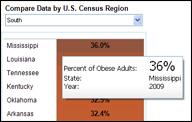
Every state in the union has fallen short of national health objectives for lowering obesity rates, according to new data from the Centers for Disease Control.
The objectives are part of Healthy People 2010, a set of national health goals developed by the U.S. Department of Health and Human Services in partnership with other federal agencies and business and community organizations.
In all, 30 states reported an increase in obesity prevalence from 2008 to 2009. Louisiana had the highest increase, from 30 percent to 34.4 percent. Oregon's obesity rate actually declined from 25.5 percent to 23.9 percent.
The data, gathered from the most recent Behavioral Risk Factor Surveillance System survey, show 2009 state-level, self-reported obesity rates for adults 20 years of age and up. Another report released this week using the same data found similar, though slightly different results. That release, from the CDC's Morbidity and Mortality Weekly Report, counts adults starting at age 18 rather than age 20.
Adults are considered obese when they have a body mass index, or BMI, of greater than 30. BMI equals a person's weight in kilograms divided by height in meters squared.
Explore the new data for ages 20 and up, and compare it to previous years going back to 2006, using the interactive chart below.
Survey Methodology
BRFSS is a state-based system of telephone surveys in which participants are asked their height and weight in order to calculate BMI. Research has shown that people consistently under report weight and over-report height in telephone surveys, resulting in significantly lower estimates of obesity prevalence. For example, from 2005-2008 national estimates of adult obesity based on self-reported height and weight ranged from 25.6-27.2 percent while estimates based on measurement via the National Health and Nutrition Examination Survey revealed a 34 percent obesity rate.
Obesity is one of the 20 key health indicators selected by the Institute of Medicine as "yardsticks to measure the overall health and well being of Americans." In naming obesity as a key measure, the IOM cited the dramatic rise in the past 30 years and evidence linking obesity and hypertension, osteoarthritis, dyslipidema, type two diabetes, coronary heart disease, stroke, gallbladder disease, sleep apnea and other respiratory problems and some cancers.
Data visualization by Anthony Calabrese, a State of the USA Web producer.
 Print This
Print This RSS Feed
RSS Feed